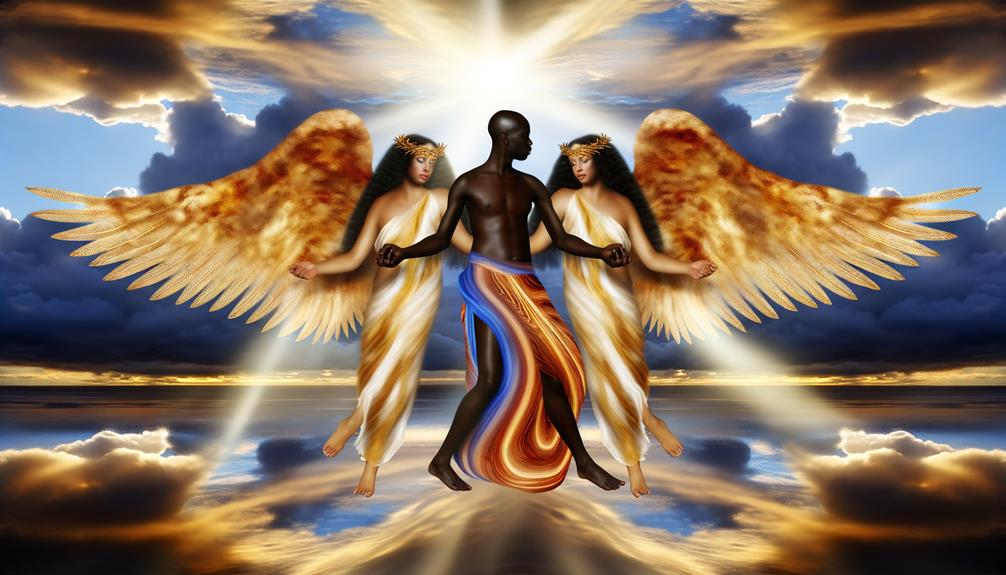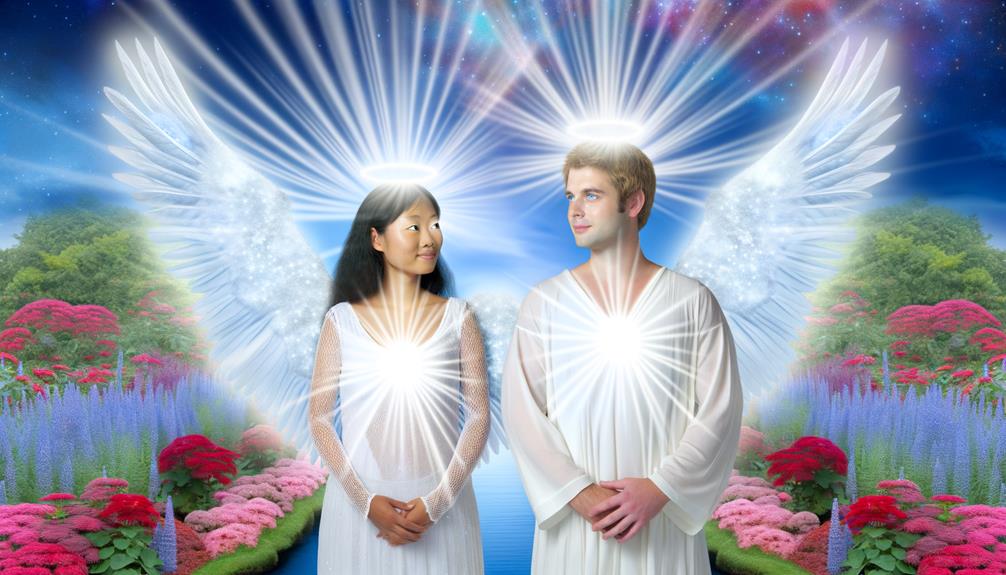Meaning Of Twins In The Bible: Symbolism and Stories
In the Bible, twins often symbolize divine complexity and the intricate interplay between human agency and God’s sovereignty. The narratives of Esau and Jacob, and Perez and Zerah, highlight themes of conflict, divine election, and birthright.
Esau’s impulsive sale of his birthright and Jacob’s deceptive acquisition underline the gravity of divine favor and covenant promises. Similarly, Perez’s unexpected precedence over Zerah emphasizes divine intervention over human norms.
These stories reflect deeper spiritual truths about divine plans, human relationships, and the reconciliation of conflicts, inviting further exploration into their theological and historical contexts.

Meaning of Twins in the Bible: Symbolism, Stories, and Spiritual Insight
| Aspect | Details |
|---|---|
| Term | Twins |
| Biblical Reference | Genesis 25:24 – Jacob and Esau |
| Meaning | Two born from the same womb |
| Symbolism | Duality, conflict, purpose, destiny, divine selection |
| Notable Twins | Jacob & Esau, Perez & Zerah (Genesis 38:27) |
| Spiritual Insight | Represents contrast (flesh vs spirit, struggle vs blessing), divine plan |
| Thematic Lessons | God’s sovereignty, sibling dynamics, fulfillment of prophecy |
Esau and Jacob

The biblical narrative of Esau and Jacob, found in the Book of Genesis, offers a profound exploration of themes such as familial conflict, divine election, and the complexities of human nature.
Born to Isaac and Rebekah, the twins embody contrasting destinies and personalities. Esau, the eldest, is a skilled hunter favored by Isaac, while Jacob, a quiet man dwelling in tents, is Rebekah’s favorite.
Their story is marked by Jacob’s acquisition of Esau’s birthright and blessing, actions that provoke deep-seated familial tensions. This account, rich in theological significance, illustrates the dynamics of divine choice and human agency.
It underscores the interplay between divine providence and individual actions, setting the stage for Israel’s complex spiritual heritage.
Divine Rivalry

Divine rivalry in the biblical context often manifests through the complex relationships and interactions between chosen individuals and their counterparts, reflecting deeper spiritual and moral lessons.
The story of Esau and Jacob exemplifies this theme, illustrating the tension between divine selection and human agency. Historically, such rivalries underscore God’s sovereign choices, which often defy human expectations and norms.
Scripturally, the narrative in Genesis 25-27 highlights God’s providential control over destinies, as seen in the pre-birth prophecy regarding Jacob and Esau. These accounts teach that God’s plans transcend human understanding, emphasizing themes of grace, mercy, and justice.
The rivalry serves as a metaphor for spiritual struggles, offering profound insights into the nature of divine election and moral responsibility.
Birthright and Blessing

Birthright and blessing in the biblical narrative of Jacob and Esau reveal profound theological insights into the dynamics of inheritance, divine favor, and covenantal promises.
In Genesis 25:29-34, Esau’s impulsive sale of his birthright to Jacob for a meal underscores the spiritual and material significance of the birthright in ancient Israelite culture.
Later, in Genesis 27, Jacob’s deception to receive Isaac’s blessing highlights the irrevocable nature of patriarchal blessings.
These events not only reflect the tension between human actions and divine sovereignty but also foreshadow Israel’s future struggles and God’s selective favor.
The narrative invites readers to contemplate the gravity of divine promises and the responsibilities accompanying God’s favor and inheritance.
Symbolism of Twins

The symbolism of twins in the Bible often encompasses themes of duality and balance, as well as conflict and unity.
Scriptural narratives, such as those of Esau and Jacob, illustrate the complex interplay between opposing forces and the eventual reconciliation of differences.
These stories serve as theological reflections on the human condition, highlighting both the tensions and harmonies inherent in creation.
Duality and Balance
In biblical narratives, twins often embody the concept of duality and balance, serving as a profound symbol for the coexistence of opposing yet complementary forces.
The story of Esau and Jacob in Genesis illustrates this principle vividly; their contrasting natures highlight the tension between earthly desires and spiritual aspirations.
Historically, twins have been interpreted as representations of the divine balance within creation, reflecting God’s intricate design of harmony.
Scripturally, the duality seen in twins underscores themes of justice and mercy, light and darkness, and human struggle within divine providence.
This symbolic duality encourages readers to contemplate the broader theological implications of balance and the inherent interconnectedness present in God’s plan for humanity.
Conflict and Unity
Twins in biblical narratives often symbolize the profound interplay between conflict and unity, as their shared origins juxtapose their divergent paths and destinies. This dynamic is vividly illustrated through:
- Jacob and Esau: Their struggle began in the womb (Genesis 25:22) and extended throughout their lives, reflecting the tension between nations.
- Perez and Zerah: The unexpected reversal of their birth order (Genesis 38:27-30) signifies divine intervention and the unpredictability of God’s plans.
- Ephraim and Manasseh: The younger Ephraim receiving the greater blessing (Genesis 48:13-20) underscores the theme of God’s sovereign choice.
- Thomas and Matthew (early church tradition): Though not directly biblical twins, their paired missions emphasize unity in spreading the Gospel.
These examples reveal the intricate balance of divine purpose amid human conflict.
Spiritual Duality

Examining the concept of spiritual duality within the context of biblical twins reveals profound insights into the nature of human existence and divine purpose.
Scriptural narratives, such as those of Jacob and Esau, and Perez and Zerah, illustrate the inherent tension between opposing forces—good and evil, flesh and spirit. Historical context underscores that these dichotomies are not merely sibling rivalries but represent deeper spiritual truths.
For instance, Jacob’s preference for spiritual blessings over Esau’s earthly desires symbolizes the struggle within humanity to prioritize divine will over worldly pursuits. This duality echoes throughout scripture, emphasizing the importance of discernment and choice in aligning with God’s plan.
Consequently, biblical twins serve as archetypes for understanding the spiritual battles inherent in human life.
Human Relationships

By exploring the spiritual duality exemplified by biblical twins, we gain a deeper understanding of how these narratives also illuminate the complexities of human relationships within a theological framework.
These relationships manifest in various forms:
- Brotherly Bonds: The fraternal connection between Esau and Jacob reflects God’s providential role in personal destinies.
- Covenant and Kinship: The birth of Perez and Zerah to Tamar underscores the continuity of God’s promises through familial lines.
- Divine Favoritism: Instances such as the preference for Jacob over Esau illustrate divine selection and human response.
- Parental Influence: Rebekah’s guidance of Jacob in securing Isaac’s blessing highlights the impact of parental actions on sibling dynamics.
Through these examples, the Bible offers profound insights into the nature of human relationships.
Conflict and Reconciliation

The narratives of Cain and Abel, as well as Esau and Jacob, illustrate profound themes of conflict and reconciliation within the biblical text.
While Cain and Abel underscore the tragic consequences of jealousy and fratricide without resolution, the story of Esau and Jacob moves from deception and strife to eventual forgiveness and reunion.
These accounts not only reflect the complexities of human relationships but also convey theological lessons on repentance, grace, and the possibility of restored harmony.
Cain and Abel
In the biblical narrative, the story of Cain and Abel not only marks the first instance of sibling rivalry but also serves as a profound exploration of conflict and the potential for reconciliation in human relationships. This tale encapsulates several theological and moral lessons:
- Jealousy and Sin: Cain’s jealousy over God’s favor towards Abel illustrates the destructive nature of envy.
- Divine Justice: God’s confrontation of Cain post-murder emphasizes divine justice and the moral consequences of sin.
- Human Responsibility: Cain’s infamous question, ‘Am I my brother’s keeper?’ highlights the ethical duty humans have towards one another.
- Opportunity for Redemption: Despite his sin, Cain is marked by God for protection, suggesting potential for divine mercy and future reconciliation.
Examining these elements aids in understanding the complexities of human relations as depicted in Scripture.
Esau and Jacob
Within the biblical narrative, the relationship between Esau and Jacob offers a profound examination of familial conflict and the potential for reconciliation through divine intervention and personal transformation.
Historically, the twins’ discord begins with Jacob’s deception to obtain Esau’s birthright and blessing, as detailed in Genesis 25 and 27. This act leads to years of estrangement and animosity.
Scriptural analysis reveals that their eventual reconciliation, described in Genesis 33, is a pivotal moment, showcasing the power of forgiveness and God’s role in mending broken relationships.
Jacob’s personal transformation, marked by his wrestling with God and receiving a new name, Israel, highlights the spiritual journey from deceit to redemption, underscoring themes of divine grace and human repentance.
Cain and Abel

Among the earliest biblical accounts of sibling relationships, the story of Cain and Abel provides profound theological insights into themes of jealousy, sin, and divine justice. This narrative, found in Genesis 4, has been deeply analyzed for its implications on human nature and morality.
Significantly, Cain and Abel were:
- Sons of Adam and Eve: Symbolizing the first generation of humanity.
- Representatives of Different Occupations: Cain was a farmer, Abel a shepherd.
- Participants in Divine Worship: Their offerings to God highlight the importance of intention in worship.
- Subjects of God’s Judgment: Cain’s jealousy and subsequent murder of Abel underscored the severity of sin and divine retribution.
These elements underscore the story’s rich tapestry of theological and moral lessons.
Perez and Zerah

The birth of Perez and Zerah, as recorded in Genesis 38:27-30, holds profound theological significance, symbolizing the themes of struggle and divine intervention.
Their story, marked by Zerah’s initial emergence and Perez’s unexpected breakthrough, serves as a powerful metaphor for God’s sovereignty in human affairs.
Additionally, the lineage of Perez, who is an ancestor of King David and ultimately Jesus Christ, underscores the prophetic dimension of their birth, highlighting the unfolding of God’s redemptive plan throughout biblical history.
Birth and Significance
The birth of Perez and Zerah, as recounted in Genesis 38, carries profound theological significance and contributes richly to the understanding of divine intervention and covenantal lineage in biblical narratives. This event highlights several key aspects:
- Lineage of Judah: Perez becomes a direct ancestor of King David and, ultimately, Jesus Christ, underscoring the Messianic prophecy.
- Divine Providence: The unusual birth order, with Zerah’s hand emerging first followed by Perez, illustrates God’s sovereignty in human affairs.
- Covenantal Faithfulness: The story affirms God’s commitment to His covenant with Abraham’s descendants, even through unconventional means.
- Moral Complexity: The narrative involving Tamar and Judah examines themes of justice, righteousness, and redemption within the family lineage.
These elements collectively enrich the biblical portrayal of God’s plan and promises.
Symbolism in Genesis
In the story of Perez and Zerah, the symbolism woven into their birth narrative provides a profound theological insight into themes of divine election and reversal of human expectations.
As recorded in Genesis 38:27-30, Zerah’s hand emerges first, marked with a scarlet thread, indicating primacy. However, it is Perez who ultimately precedes him. This unexpected reversal mirrors the biblical motif where God’s choice defies human conventions, akin to Jacob’s supremacy over Esau.
Historically, this narrative underscores the unpredictability of divine favor and the subversion of societal norms.
Scripturally, it reinforces the sovereignty of God’s will in determining lineage, emphasizing that divine purposes transcend human understanding and expectations.
The birth of Perez and Zerah thereby epitomizes the intricate dynamics of divine providence.
Lineage and Prophecy
Lineage and prophecy converge compellingly in the narrative of Perez and Zerah, offering profound insights into the unfolding of divine purpose throughout biblical history.
These twins, born to Tamar and Judah, represent significant themes within Scripture:
- Messianic Lineage: Perez is significantly listed in the genealogy of Jesus Christ (Matthew 1:3), emphasizing his importance in the Messianic prophecy.
- Divine Reversal: The birth story, where Perez unexpectedly precedes Zerah, highlights God’s sovereignty in reversing human expectations (Genesis 38:28-30).
- Covenantal Continuity: Their story reinforces the continuity of God’s covenantal promises through generations.
- Symbolic Birthmarks: Zerah’s scarlet thread symbolizes redemption, prefiguring Christ’s sacrificial atonement.
The birth of Perez and Zerah underscores God’s meticulous orchestration of His redemptive plan across history.
Divine Plans

Scriptural narratives featuring twins often reveal profound insights into divine plans and the unfolding of God’s purpose throughout biblical history.
The story of Jacob and Esau, for example, showcases how God’s will can transcend human expectations and societal norms (Genesis 25:23). Despite Esau’s status as the firstborn, Jacob is chosen to carry forward the Abrahamic covenant, illustrating God’s sovereignty in election.
Similarly, the birth of Perez and Zerah (Genesis 38:27-30) underscores divine intervention, as Perez’s unexpected emergence reconfigures human assumptions about inheritance and destiny.
These accounts elucidate how God’s plans often challenge conventional wisdom, emphasizing His ultimate control over history and the fulfillment of His promises.
Through twins, scripture reveals the intricacies of divine orchestration.
Modern Interpretations

Modern interpretations of biblical twins continue to explore the theological implications of their stories, examining how ancient narratives resonate with contemporary understandings of divine purpose and human identity. These interpretations often consider:
- Sibling Rivalry and Reconciliation: Jacob and Esau’s story highlights the complexities of familial relationships and eventual reconciliation, mirroring modern familial dynamics.
- Divine Election and Human Agency: The preference of Jacob over Esau underscores themes of divine choice and human response, inviting reflection on predestination and free will.
- Symbolism of Duality: Twins often symbolize dual aspects of human nature, such as good and evil, or faith and doubt, prompting introspection on personal and spiritual conflict.
- Covenant and Promise: The narratives affirm God’s enduring covenant, emphasizing that divine promises persist through generations, relevant to contemporary faith communities.
Conclusion
The biblical narrative of twins, like a carefully woven tapestry, reveals intricate themes of divine rivalry, spiritual duality, and predestined plans.
Through the stories of Esau and Jacob, Cain and Abel, and Perez and Zerah, the scripture elucidates the complexities of birthright, blessing, and divine intention.
These accounts serve not only as historical records but also as profound theological insights, offering reflections on the nature of human relationships and God’s sovereign will across generations.






